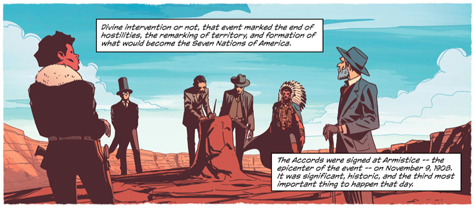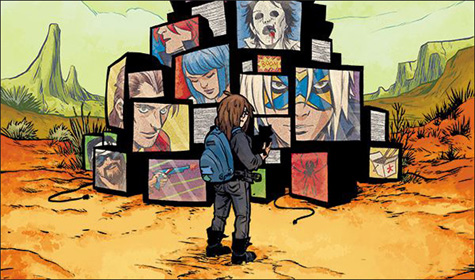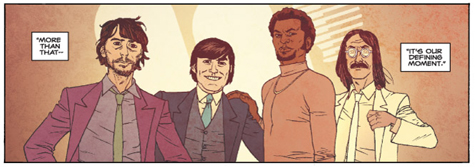Medical tests, favorite TV show finales, or the fate of the world—no one wants the future given away. It belongs to us. Until we know for sure what’s happening, we can direct which way it goes.
Three current comics triangulate our understanding of where we are based on the consequences of a future we never got, a present that might never have come, and the inevitable but illogical conclusion of the time we’re living now. Together they open a window on the next-next events we can’t look away from but don’t really wanna know.
Nowhere Men—an Image comic by Eric Stephenson, Nate Bellegarde and Jordie Bellaire—is set in an alternate timeline still very influenced by the 1960s technophilia which produced a culture of rockets, synthetic fabrics, processed foods, and utopian nuclear energy. A quartet of celebrity physicists take the place of mid-20th century pop musicians (with obvious nods to the Beatles in particular), and the book reads like a sci-fi Mad Men—Mad Scientists, shall we say.
The storyline loops in a decaying orbit around the Lab Four’s heyday, their eventual acrimonious split, their (and their competitors’) world-changing innovations, and the ominous consequences of dalliances with other dimensions and genetic modification.
Stephenson’s script is Watchmen-level in its attention to creating historical detail; Bellegarde’s precise drawing and Bellaire’s vivid color plot the imagery like an architectural diagram about to burst with elemental disorder.
In look and attitude, the comic follows a trend of pop futurism which never died out for its characters as it did for us four decades ago. The weary glitz and antiseptic menace of Kubrick’s Clockwork Orange or Roeg’s Man Who Fell to Earth infuse each page, and close a circuit with the hipster aesthetics of “our” 21st century. The rockstar scientists of Nowhere Men’s timeline are not so different from the celebrity programmers of our own, but they’re a lot less well-behaved and well-meaning, suggesting a vision of a future we’ve only now grown into and circled around to; a hard-fought, austerely reassuring fable of what might have gone wrong if we’d had that much that soon.

The question of how we’d be living if the “future” we’re actually inhabiting had never come about is explored in East of West, another Image comic, written by Marvel’s go-to metaphysician Jonathan Hickman, with art by Nick Dragotta and colors by Frank Martin.
Like all such fictions, East of West is about what’s really happening now, based on a revealing parable of what might have happened back when, or a long time from today—the cultural fault-lines that still underlie our uneasy America are hardened fragments in this comic’s world, seven nations defined by a Civil War that, rather than binding up the country, cemented in place segregated states of Imperial Chinese immigrants, Afrocentric ex-slaves, unrepentant Confederates, unconquered Natives, a curtailed northeastern “Union,” and of course, Texas.
This is a perilous social landscape riven by mystic perspectives and permanent end-times prophecy. A recurrent band of apocalyptic Four Horseman figures, as well as the embodied Death himself, roam between its borders. Hickman is a master at making you feel like you’re remembering your own national history or family saga—rather than piling exposition on you—and his textured narrative is as fascinating as his breakneck incidents are (East of West’s reality is a physically brutal world as much as it is a conceptually rich and momentously speech-prone one).
Dragotta’s art, alternately pop-mod and feverishly surreal, perfectly puts us in surroundings that are deceptively familiar and overwhelmingly spectacular, and together the creative team have fashioned a fusion of archaic American fashions and sci-fi design (the story stretches between the 1860s and the 2060s) that may surpass even the Hunger Games movies for immersing the viewer in an environment of eerie undead tradition and suspicious millennial awe.

Our rush into isolating technologies and consumer addictions is the future that’s fast overtaking us, portrayed in Dark Horse Comics’ The True Lives of the Fabulous Killjoys as a present day that overlays our own, perceived by writers Gerard Way & Shaun Simon, artist Becky Cloonan and colorist Dan Jackson.
Based on a My Chemical Romance album, the comic pushes us out onto the roadside of a blasted America of desert voids and claustrophobic metropolises. Life has turned inside-out with metaphor, as wasteland-dwelling rebels face off fitfully against conformist drones from the big city. But that description does no justice to the shaded, scattered set of social relations Way and Simon have set up in their fascinating first issue. We’re not in a no-one’s-land of pop convention but a forest of wordplay and fresh ideas, the diverse bohemian factions, melancholy A.I.s and shadowy agents of the State playing out a cacophonous conflict that relates to free will but will need many more issues to be fully grasped.
Jackson’s color tattoos the back wall of your brain, and Cloonan is on a career high, lending a painterly chaos to the desert’s unrestrictable landscape and a psychodramatic clutter to the dystopian city’s imprisoning gloom; the full profusion of life and vibrant accumulation of culture are her palette, populated by the slashing contours of her characters’ form and the nervous, acid rainbow of their expression.
Like a song, the poetic, telegraphic dialogue and piecemeal kaleidoscope of Killjoys’ storyline is collaged from fragments of media echo and mental impression, East of West is told in its own world’s shattered structure, converging on the core of the story, and Nowhere Men’s jumpy narrative, cycled ambitiously between the comic sequence and ephemera from within its world (media clippings, book excerpts, etc., again as in Watchmen but even more committed to it) is like going through a pile of records of this tomorrow that didn’t come, catching up like the coma-sleeper one of the characters is, following a scientific process of assembled understanding to maybe wake up to the world.
The future of that world is uncertain, but the horizons of comics, unpredictable, renewed, are to be found on these three series’ assured, multiplying paths.
Adam McGovern’s dad taught comics to college classes and served as a project manager in the U.S. government’s UFO-investigating operation in the 1950s; the rest is made up. There is material proof, however, that Adam has written comic books for Image (The Next issue Project), Trip City.com, the acclaimed indie broadsheets POOD and Magic Bullet, and GG Studios, blogs regularly for HiLoBrow.com and ComicCritique and posts at his own risk on the recently launched Fanchild. He lectures on pop culture in forums like The NY Comics & Picture-story Symposium and interviewed time-traveling author Glen Gold at the back of his novel Sunnyside (and at this link). Adam proofreads graphic novels for First Second, has official dabblings in produced plays, recorded songs and published poetry, and is available for commitment ceremonies and intergalactic resistance movements. His future self will be back to correct egregious typos and word substitutions in this bio any minute now. And then he’ll kill Hitler, he promises.










